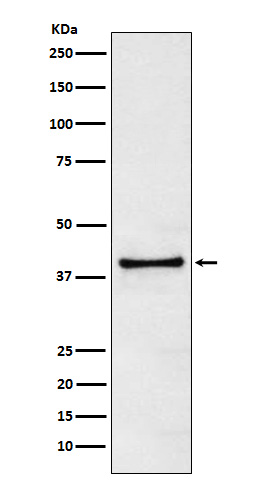
| WB | 1/500-1/1000 | Human,Mouse,Rat |
| IF | 1/20 | Human,Mouse,Rat |
| IHC | 咨询技术 | Human,Mouse,Rat |
| ICC | 技术咨询 | Human,Mouse,Rat |
| FCM | 咨询技术 | Human,Mouse,Rat |
| Elisa | 咨询技术 | Human,Mouse,Rat |
| Aliases | C20orf97; NIPK; SINK; SKIP3; TRB3; Trib3; Tribbles homolog 3; Tribbles pseudokinase 3; Tribbles3 |
| Entrez GeneID | 57761 |
| WB Predicted band size | Calculated MW: 40 kDa; Observed MW: 40 kDa |
| Host/Isotype | Rabbit IgG |
| Antibody Type | Primary antibody |
| Storage | Store at 4°C short term. Aliquot and store at -20°C long term. Avoid freeze/thaw cycles. |
| Species Reactivity | Human |
| Immunogen | A synthesized peptide derived from human TRIB3 |
| Formulation | Purified antibody in PBS with 0.05% sodium azide. |
+ +
以下是关于TRIB3抗体的3篇参考文献,按研究领域分类简要概括:
1. **文献名称**:*TRIB3 regulates endoplasmic reticulum stress-induced cell death via interaction with CHOP in colorectal cancer*
**作者**:Li K., et al.
**摘要**:研究通过Western blot和免疫共沉淀技术,利用TRIB3抗体揭示TRIB3与CHOP蛋白相互作用调控结直肠癌细胞在ER应激下的凋亡机制。
2. **文献名称**:*TRIB3 contributes to insulin resistance by targeting Akt for degradation in adipocytes*
**作者**:Du K., et al.
**摘要**:该文献通过免疫荧光和免疫沉淀实验(使用TRIB3特异性抗体),证明TRIB3通过降解Akt蛋白加剧脂肪细胞胰岛素抵抗,为代谢疾病提供新靶点。
3. **文献名称**:*TRIB3 promotes glioblastoma progression by inhibiting protein degradation of β-catenin*
**作者**:Wang J., et al.
**摘要**:研究利用TRIB3抗体进行免疫组化分析,发现TRIB3通过稳定β-catenin蛋白表达促进胶质母细胞瘤侵袭,提示其作为癌症治疗潜在靶点。
---
**注**:若需具体年份或期刊信息,可补充说明。建议通过PubMed或Sci-Hub输入DOI/标题进一步获取全文。
TRIB3 (Tribbles homolog 3) is a pseudokinase protein encoded by the *TRIB3* gene, belonging to the Tribbles family of serine/threonine kinase-like proteins. Unlike typical kinases, TRIB3 lacks catalytic activity due to critical substitutions in its kinase domain. It functions as a stress-responsive regulatory molecule, interacting with key signaling components such as Akt, MAPK, and transcription factors (e.g., ATF4. CHOP) to modulate cellular processes including apoptosis, metabolism, autophagy, and endoplasmic reticulum (ER) stress. TRIB3 is implicated in diseases like cancer, diabetes, and neurodegenerative disorders, where its expression is often dysregulated.
Antibodies targeting TRIB3 are essential tools for studying its expression, localization, and interactions. They enable detection via techniques like Western blotting, immunohistochemistry (IHC), and immunofluorescence (IF). Due to structural similarities among Tribbles family members (TRIB1. TRIB2. TRIB3), antibody specificity is critical to avoid cross-reactivity. Some TRIB3 antibodies are designed to recognize unique epitopes in its N-terminal or pseudokinase domain. Research applications include exploring TRIB3's role in tumor progression (e.g., EMT, drug resistance) or metabolic pathways (e.g., insulin signaling). Commercial antibodies often undergo validation in knockout models to confirm specificity. Challenges remain in detecting post-translational modifications or context-dependent conformational changes. Reliable TRIB3 antibodies are vital for advancing its potential as a therapeutic target or biomarker.
×